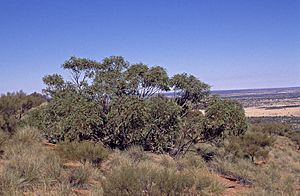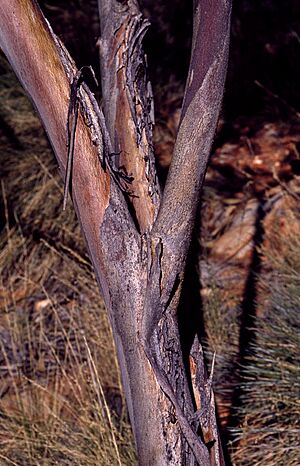Mount Gillen mallee facts for kids
Quick facts for kids Mount Gillen mallee |
|
|---|---|
 |
|
| Eucalyptus gillenii in the Petermann Ranges | |
| Scientific classification | |
| Genus: |
Eucalyptus
|
| Species: |
gillenii
|
The Mount Gillen mallee (scientific name: Eucalyptus gillenii) is a special type of mallee tree. It is also known as the mallee red gum or Mt Lindsay mallee. This plant is found only in inland Australia. It has smooth, patchy bark and long, narrow leaves. Its flowers are white and grow in groups of seven or nine. The fruit looks like a half-sphere or a cup.
Contents
What the Mount Gillen Mallee Looks Like
The Eucalyptus gillenii is a type of mallee tree that usually has many stems. It can grow to be about 2 to 6 meters (6.5 to 20 feet) tall. This tree has a special woody swelling at its base called a lignotuber. This helps it regrow after fires.
The bark of the Mount Gillen mallee is smooth and has patches of grey and brownish colors. Young plants and new shoots from the base (called coppice regrowth) have stems that are somewhat square. Their leaves are shaped like a spear, about 70 to 100 millimeters (2.7 to 4 inches) long and 10 to 40 millimeters (0.4 to 1.6 inches) wide.
Adult leaves are a dull green to blue-green color. They can be straight and narrow or slightly curved. These leaves are 70 to 180 millimeters (2.7 to 7 inches) long and 9 to 26 millimeters (0.35 to 1 inch) wide. They grow on a stalk called a petiole, which is 8 to 30 millimeters (0.3 to 1.2 inches) long.
The flower buds grow in groups of seven or nine. They are found where the leaves meet the stem (called a leaf axil). Each group of buds grows on a short stem called a peduncle, which is 4 to 13 millimeters (0.16 to 0.5 inches) long. Each individual bud has its own tiny stalk, called a pedicel, about 1 to 4 millimeters (0.04 to 0.16 inches) long.
When the buds are ready to open, they are oval-shaped. They are 7 to 16 millimeters (0.27 to 0.63 inches) long and 4 to 7 millimeters (0.16 to 0.27 inches) wide. The top part of the bud, which covers the flower, is called an operculum. It can be rounded or cone-shaped.
The Mount Gillen mallee flowers from February to April or from November to December. Its flowers are a creamy white color. After flowering, the tree produces a woody fruit called a capsule. These capsules are shaped like a globe, a half-sphere, or a cup. They are 3 to 9 millimeters (0.12 to 0.35 inches) long and 6 to 12 millimeters (0.24 to 0.47 inches) wide. Inside, they hold dark brown, pyramid-shaped seeds. These seeds are about 1.5 to 3 millimeters (0.06 to 0.12 inches) long and 0.8 millimeters (0.03 inches) wide.
How the Mount Gillen Mallee Got Its Name
The Eucalyptus gillenii was officially described in 1926. Two scientists, Alfred Ewart and Lesley Kerr, wrote about it in a scientific paper called Proceedings of the Royal Society of Victoria. They studied samples that Ewart had collected in 1924 near a place called Mount Gillen.
The tree was named after Francis James Gillen. He was an anthropologist, which means he studied human societies and cultures. He was also an ethnologist, studying different ethnic groups. Francis Gillen was the first postmaster in Alice Springs, a town in Australia. Mount Gillen, where the first samples of the tree were found, was also named after him.
Where the Mount Gillen Mallee Lives
This special mallee tree is commonly found on rocky hills in the central and southwestern parts of Central Australia. You can see it a lot in the MacDonnell Ranges and Petermann Ranges. These areas are in the Northern Territory and Western Australia.
It is less common in some other places, like Mount Wooltarlinna and Mount Lindsay. These are in the Birksgate Range in the far northwest of South Australia. There is also a small group of these trees far away at Skirmish Hill in the Dean Range in Western Australia.
The Mount Gillen mallee likes to grow in cracks and crevices on and at the bottom of large rock formations, especially where water runs off. In South Australia, it often grows alongside other trees like Corymbia eremaea and Eucalyptus intertexta.
Conservation Status
The Western Australian Government's Department of Parks and Wildlife has looked at the Mount Gillen mallee. They have classified this eucalypt as "not threatened." This means it is not currently at risk of disappearing.
Using the Mount Gillen Mallee in Gardens
The mallee red gum is a strong and easy-to-grow plant. It can handle both frost (very cold temperatures) and drought (long periods without rain). This makes it a good choice for gardens in areas with tough climates.


